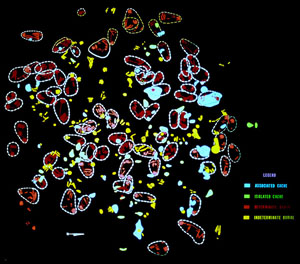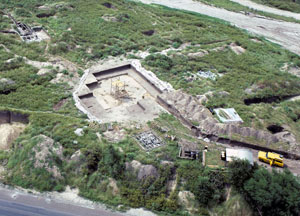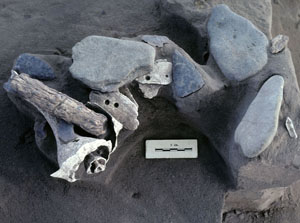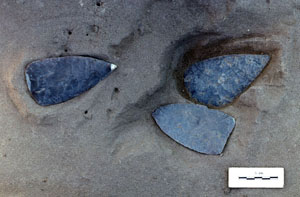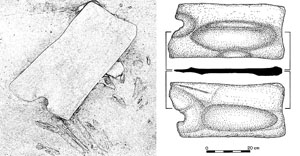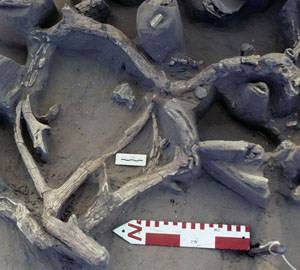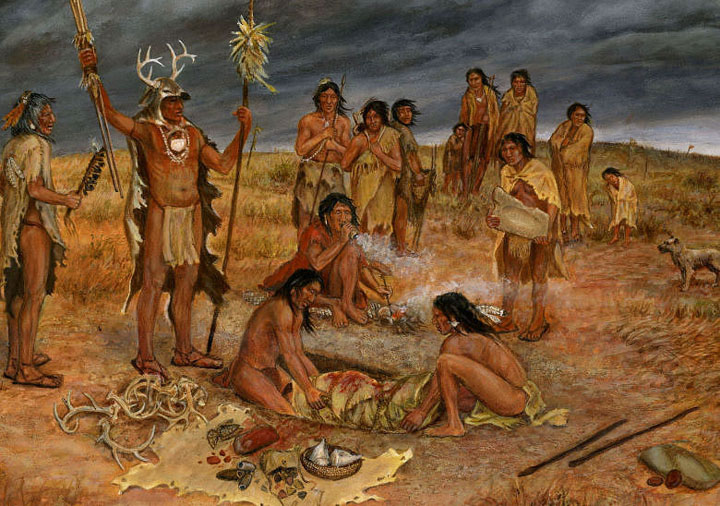
A burial party lays a loved one to rest at Loma Sandia, about 2700 years ago. This interpretive painting by TBH artist
Frank Weir accurately depicts some of the archeological evidence documented at this ancient cemetery site.
Other elements reflect the local landscape and climate. The scene is set on a winter day, just as a �blue norther� arrives,
an auspicious moment for a funeral. |
Loma Sandia
The Loma Sandia site (41LK28) is a large prehistoric cemetery situated on a sandy knoll overlooking Hackberry Creek, a small intermittent tributary of the Frio River in northern Live Oak County near the town of Three Rivers. Excavations there uncovered a campsite and late Middle Archaic cemetery which contained the skeletal remains of over 200 individuals. The burials and grave offerings at Loma Sandia provided many insights into southern Texas prehistory, including evidence of interaction between the groups who lived in the area near Loma Sandia and groups along the Texas Gulf coast and, to a lesser extent, in Central Texas.
Archeologists from the Texas Highway Department (now TxDOT) discovered the Loma Sandia site in 1973 in advance of the construction of IH 37. Excavations at the site started in 1977 and continued into the following year. Though preliminary results were reported in 1977, comprehensive analysis and reporting of the site was not completed until 1995. The final site report by Anna J. Taylor and Cheryl L. Highley spans two volumes and represents a multi-disciplinary effort from a team of researchers familiar with South Texas prehistory.
Dates from the cemetery at Loma Sandia indicate that it was used during a relatively short period of time between about 850 and 550 B.C., which falls within the latter part of the Middle Archaic period according to the south Texas chronological scheme. According to the better dated and more refined central Texas chronology, dart point styles found within the Loma Sandia cemetery (such as Pedernales points) fall within the later part of the Late Archaic period. Unfortunately, the south Texas chronology is not yet refined and aligned with adjacent regions. Viewed from a larger perspective of the Eastern United States, the Loma Sandia cemetery was used in the latter part of the Archaic era.
Although only a modest sample of the burials were dated, the apparent limited use span of the Loma Sandia cemetery (ca. 850-550 B.C.) stands in contrast to other Archaic cemeteries such as Ernest Witte (41AU36) and Buckeye Knoll (41VT98), which were used repeatedly over 1,000 years or more. The significance of this short period of use is not fully understood, but it may mark a period during which the group or groups who buried their dead at Loma Sandia were semi-sedentary and had a relatively fixed territory. Logically, the cemetery location would have been in a frequently visited “central” area of the territory.
Most of the human remains were not well preserved and some mixing had occurred due to natural and cultural disturbances to the sandy soil including animal burrowing, root growth, and ancient pit digging. The burial population is estimated to represent a minimum of 205 individuals. Of the 75 individuals for whom gender could be assessed, 31 appear to have been female and 44 male. Similarly, of those individuals for whom age could be estimated, 72% were adult, 13% adolescents (10-19 years old), and 15% were children (less than 10 years old). Only 13 males and 4 females are thought to have been over 40 years old.
Most of the burials were primary inhumations, meaning that the deceased appear to have been carried to the cemetery soon after they died and their bodies were still intact. With few exceptions, all of the bodies were laid on their sides in a flexed position (bent knees and arms). There were 10 cremations including the charred remains of 3 adult males that appear to have been cremated elsewhere and brought to the site. These same individuals appear to have been treated differently in ways that suggest they had special status. For instance, two of the adult male cremations had deer antler racks placed over their graves.
A wide variety of mortuary offerings were found at Loma Sandia, including dart points, other chipped stone tools, tubular stone pipes, grinding slabs and manos, marine shells, asphaltum, various minerals in unaltered cobbles, and antler racks of white-tailed deer. Yet when compared with other cemeteries in the region, the large number of chipped stone tools associated with burials at Loma Sandia stands out. Tortugas dart points, distally-beveled tools, thin bifaces (knives) and cores were particularly common. Analysis of the burials revealed some disparity between grave goods associated with males and those associated with females. Knives, antler racks, modified mussel shell, unifaces, and smoothed flakes were found exclusively in male burials while shark teeth, asphaltum and certain dart points (Morhiss, Abasolo, and Pedernales) were found exclusively with female burials.
The mortuary items at Loma Sandia provide good evidence of interaction between the occupants of the site and groups on the Gulf coast and in central Texas. The presence of marine shell, shark teeth, and Morhiss dart points indicates that the groups at Loma Sandia had extensive contact with coastal groups or visited the coast themselves (a distance of only 60-70 miles). Traces of asphaltum (which is found washed up on coastal beaches) was also found on the stems of some Lange and Morhiss dart points, used as a hafting adhesive. Several large knives made of high-quality chert from the Edwards Plateau probably represent trade items.
The Loma Sandia site has forced archeologists to reconsider many of their previous interpretations of South Texas prehistory. Prior to the Loma Sandia research, it was believed that burials in the interior of South Texas were usually isolated graves left by small groups constantly on the move. The large Loma Sandia cemetery seems to imply fixed territories and larger social groups beyond small bands. Finally, evidence of trade items indicates that social networks were extensive, ranging over several hundred miles. The discovery of a well-preserved late Middle Archaic cemetery at Loma Sandia suggests that there are probably others like it that have yet to be found.
Sources
See Silo, Morhiss Mound, Olmos Dam, and Buckeye Knoll for related cemetery discussions and Mortuary Traditions for an overview.
Broehm, Cory J.
2001 Hunter-Gatherer Stress: An Example from Prehistoric South and Southwest Texas. Unpublished M.A. thesis, University of Sheffield, United Kingdom.
Perttula, Timothy K.
2001 Hunter-Gatherer Mortuary Practices in the Rio Grande Plains and Central Coastal Plains
Archeological Regions of Texas. La Tierra 28(3):2-83.
Taylor, Anna J. and Cheryl L. Highley
1995 Archeological Investigations at the Loma Sandia Site (41LK28), A
Prehistoric Cemetery and Campsite in Live Oak County, Texas.
Studies in Archeology 20, Texas Archeological Research
Laboratory, The University of Texas at Austin.
